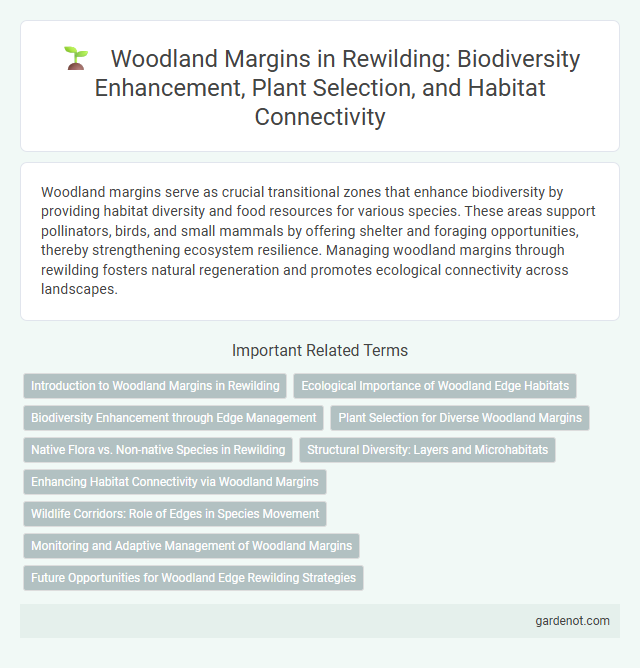Woodland margins serve as crucial transitional zones that enhance biodiversity by providing habitat diversity and food resources for various species. These areas support pollinators, birds, and small mammals by offering shelter and foraging opportunities, thereby strengthening ecosystem resilience. Managing woodland margins through rewilding fosters natural regeneration and promotes ecological connectivity across landscapes.
Introduction to Woodland Margins in Rewilding
Woodland margins serve as vital ecotones in rewilding projects, enhancing biodiversity by providing habitat connectivity and edge effects between forest and open land. These transitional zones support diverse flora and fauna, promoting natural regeneration and resilience within rewilded landscapes. Managing woodland margins carefully facilitates the establishment of native species and improves ecosystem services like pollination and soil stabilization.
Ecological Importance of Woodland Edge Habitats
Woodland margins serve as vital ecological zones where diverse plant and animal species thrive, forming rich biodiversity hotspots. These edges facilitate nutrient exchange and provide critical habitats for pollinators, small mammals, and birds, enhancing ecosystem resilience. Maintaining healthy woodland margins supports natural pest control, soil stabilization, and climate regulation within rewilded landscapes.
Biodiversity Enhancement through Edge Management
Woodland margins create critical habitat heterogeneity that supports diverse flora and fauna by fostering microhabitats and resource-rich transition zones. Effective edge management enhances biodiversity by maintaining structural complexity, promoting native species growth, and controlling invasive plants. This approach increases habitat connectivity and ecological resilience, benefiting pollinators, birds, and small mammals in rewilding projects.
Plant Selection for Diverse Woodland Margins
Selecting native plant species such as hawthorn (Crataegus monogyna), blackthorn (Prunus spinosa), and spindle (Euonymus europaeus) enhances biodiversity in woodland margins by providing food and habitat for pollinators, birds, and small mammals. Incorporating a mix of shrubs, herbaceous plants, and grasses creates structural diversity essential for supporting different wildlife species and improving ecological resilience. Prioritizing species adapted to local soil and climate conditions ensures successful establishment and long-term sustainability of rewilded woodland edges.
Native Flora vs. Non-native Species in Rewilding
Woodland margins rich in native flora support biodiversity by providing essential habitats and food sources for endemic wildlife, enhancing ecosystem resilience. Non-native species often outcompete native plants, disrupting local ecological balance and hindering rewilding efforts aimed at restoring natural habitats. Maintaining native vegetation at woodland edges is critical for successful rewilding projects focused on ecosystem recovery and species conservation.
Structural Diversity: Layers and Microhabitats
Woodland margins with structural diversity support essential layers such as shrubs, understory plants, and ground vegetation, creating diverse microhabitats that boost biodiversity. These layered structures provide food sources, nesting sites, and shelter for insects, birds, and small mammals, enhancing ecosystem resilience. Incorporating varied plant heights and densities in rewilding projects strengthens habitat complexity and promotes natural ecological processes.
Enhancing Habitat Connectivity via Woodland Margins
Woodland margins serve as critical corridors that enhance habitat connectivity by linking fragmented forests and providing safe passage for wildlife. These edge habitats support diverse plant and animal species, improving ecosystem resilience and facilitating natural migration and dispersal. Effective management of woodland margins promotes biodiversity, carbon sequestration, and the overall health of rewilding landscapes.
Wildlife Corridors: Role of Edges in Species Movement
Woodland margins serve as critical wildlife corridors, facilitating species movement and genetic exchange between fragmented habitats. These edges provide diverse microhabitats and food resources, supporting a variety of flora and fauna including pollinators, small mammals, and birds. Maintaining connected woodland margins enhances biodiversity and ecosystem resilience by enabling safe passage and access to essential resources across the landscape.
Monitoring and Adaptive Management of Woodland Margins
Monitoring woodland margins involves systematic assessment of biodiversity indices, soil quality, and edge effects to detect ecological shifts over time. Adaptive management integrates real-time data on species composition, invasive species encroachment, and microhabitat changes to refine conservation strategies and enhance habitat connectivity. Employing remote sensing technologies and citizen science enhances data accuracy, enabling dynamic interventions that promote resilient and diverse woodland margin ecosystems.
Future Opportunities for Woodland Edge Rewilding Strategies
Woodland margin rewilding offers significant potential to enhance biodiversity by promoting native species regeneration and creating vital habitats for pollinators and small mammals. Future opportunities focus on integrating natural succession processes with targeted planting of drought-resistant native shrubs to build ecological resilience against climate change. Expanding these strategies can create continuous wildlife corridors that support species migration and improve ecosystem connectivity at the landscape scale.
Woodland margin Infographic

 gardenot.com
gardenot.com